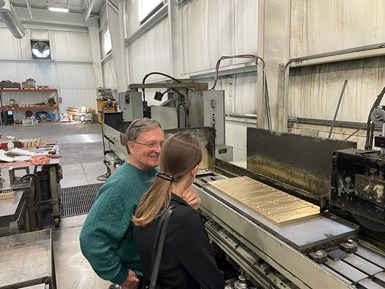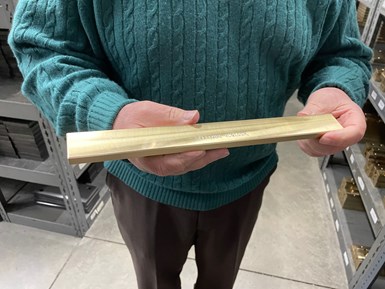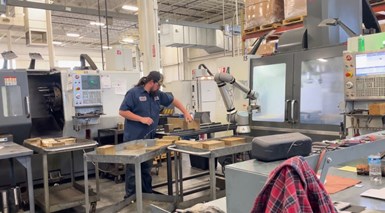
SelfLube President Phil Allor describes the grinding process to MoldMaking Technology Editorial Director Christina Fuges. All Photos Credit: MoldMaking Technology
The MoldMaking Technology team hit the road recently for a week’s worth of shop visits, school tours and sales calls. One appointment was with SelfLube – a longtime supporter of MMT and the moldmaking industry – a manufacturer of conventional and self-lubricating mold components in both inch and metric sizes. The product line consists of more than 10,000 standard part numbers, but they are also set up to offer unique pieces the require special sizes. The SelfLube team attributes its ability to accommodate standard and custom mold component solutions to its flexibility aided by automation.

Stepping onto the shop floor during this visit immediately reminded me that SelfLube is a small manufacturer with many of the same challenges as our mold-building readers. I often forget that many of our advertisers are manufacturers too😊 This also reminded me of a conversation I had with SelfLube President Phil Allor a couple of years ago concerning his year-and-a-half journey to automate the company’s high-mix, low-volume manufacturing environment with a Universal Robot robotic arm on a Haas machining center.

So I thought I’d share that story again but this time with some of our own photos and a video clip of the robot in action shot by MMT Digital Editor Cara Decknadel. Click here to read the whole story.
RELATED CONTENT
-
VIDEO: Can You Integrate a Joystick onto a Robot for Mold Repair?
Tony Demakis, President of Alliance Specialties and Laser Sales and Brian Conner, Channel Development Manager at Universal Robots answer the question of whether or not you can integrate a joystick onto a robot for mold repair.
-
A Few Words on Humans and Robots Working Together to Revitalize Manufacturing
It’s time to rethink what a manufacturing job is and what we can comfortably leave for robots.
-
Outlook for Automation in 2024
I want to share an article I found that discusses the reasons manufacturers should adopt automation in 2024 as a strategic response to global uncertainties, reshoring requirements, labor shortages and the pursuit of increased productivity.











